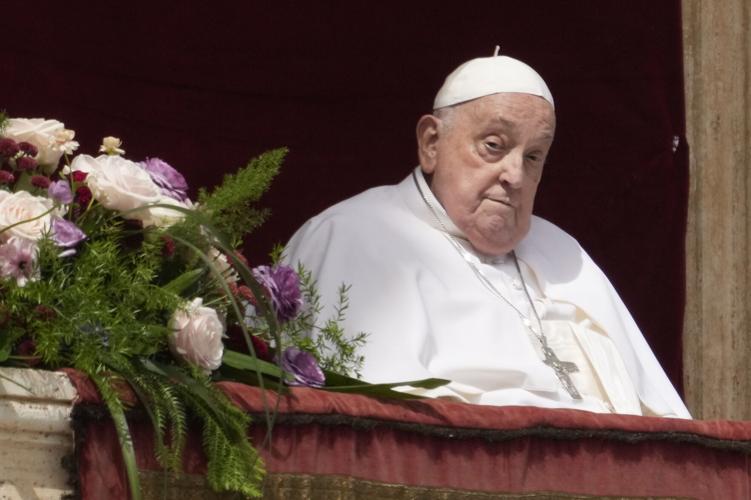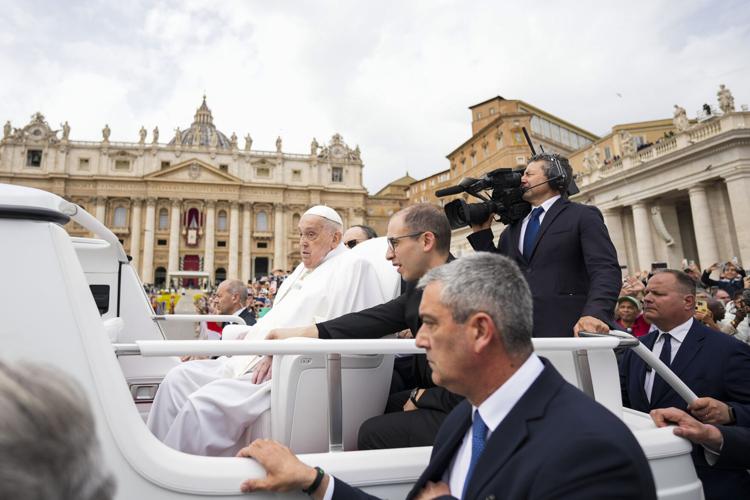What does it mean when a figure of global spiritual significance takes their final bow, leaving behind a legacy etched in the hearts of millions? Pope Francis's final Easter appearance, a poignant reminder of life's fragility, marked not just the end of a tradition, but the beginning of a new chapter in the narrative of the Catholic Church.
On the sun-drenched morning of April 20, 2025, the heart of Vatican City, St. Peter's Square, pulsed with anticipation. Thousands had gathered, drawn by the magnetic pull of Easter Sunday, a day of profound spiritual significance for Christians worldwide. Amidst the joyous atmosphere, a shadow of concern lingered, as the pontiff, Pope Francis, had been battling health issues, his recent convalescence casting a pall over his ability to participate fully in the festivities. Despite his weakened state, the Pope, in a gesture that would ultimately become his last public act, chose to greet the faithful. His brief appearance, a blessing offered to the crowd gathered below, was a testament to his unwavering commitment to his flock, even in the face of personal adversity.
| Attribute | Details |
|---|---|
| Full Name | Jorge Mario Bergoglio |
| Born | December 17, 1936, in Buenos Aires, Argentina |
| Died | April 21, 2025, in Vatican City |
| Papacy Began | March 13, 2013 |
| Predecessor | Benedict XVI |
| Successor | Vacant (at the time of this writing) |
| Education | Master's degree in Chemistry; Jesuit training |
| Ordination | Priest: December 13, 1969; Bishop: June 27, 1992; Cardinal: February 21, 2001 |
| Previous Roles | Archbishop of Buenos Aires (1998-2013); Cardinal (2001-2013) |
| Key Initiatives | Emphasis on mercy, compassion, and social justice; advocacy for the poor and marginalized; reform of the Vatican's financial practices; efforts toward interreligious dialogue and environmental protection. |
| Notable Writings | Evangelii Gaudium (The Joy of the Gospel), Laudato Si' (Praise Be) |
| Legacy | Known for his humility, approachability, and focus on pastoral care; his efforts to modernize the Church and address contemporary issues; a significant influence on global politics and ethical discussions. |
| Reference | The Holy See - Pope Francis |
The air in St. Peter's Square crackled with a mixture of reverence and expectation. The traditional Easter blessing, Urbis et Orbi ("to the city and to the world"), was delivered, albeit in a slightly altered format. While the Pope's physical presence was limited, his spirit permeated the square. He appeared briefly on the balcony of St. Peter's Basilica, offering a concise greeting and a blessing to the assembled masses, a powerful testament to his enduring connection with the faithful. The image of Pope Francis, frail yet resolute, became an indelible image, encapsulating the essence of Easter a celebration of life, resilience, and hope.
The Pope's Easter message, a cornerstone of his papacy, was read aloud by an aide, underscoring the themes of hope, peace, and reconciliation. The message addressed a world grappling with conflict, suffering, and injustice. He called for an immediate ceasefire in Gaza, prayed for the Holy Land, Ukraine, Myanmar, Syria, Lebanon, and Africa, and remembered the victims of human trafficking, the unborn, and all those enduring hardship. His words, filled with compassion and concern, reflected his unwavering commitment to social justice and his profound empathy for those on the margins of society.
That same day, April 20, 2025, marked the beginning of the end. The Pope, despite his failing health, engaged in a busy schedule. He met with Vice President J.D. Vance and blessed those gathered for Easter, demonstrating a desire to fulfill his duties and engage with the world. This was a testament to his dedication, even when his doctors had urged him to rest. The subsequent passing of Pope Francis, on Easter Monday, April 21, 2025, at the age of 88, marked not only the end of an era but served as a stark reminder of the transient nature of life. He died at his residence in the Vatican's Casa Santa Marta, bringing to a close a papacy marked by significant change and lasting impact.
Cardinal Kevin Farrell, Camerlengo of the Holy Roman Church, announced the death of Pope Francis from the Casa Santa Marta, at 9:45 am. His words echoed through the Vatican, conveying the news to a world still reeling from the events of the previous day. The passing of Pope Francis was a moment of profound sadness for the global Catholic community and indeed, for all who admired his leadership and moral vision.
Pope Francis's final address, delivered on that Easter Sunday, remains a powerful reminder of his values. His call for peace, compassion, and justice resonated with millions across the globe, cementing his legacy as a leader who put service to others at the heart of his papacy. His final words, a blessing offered to the world, encapsulated his lifelong dedication to his faith and his unwavering belief in the power of love and hope.
The images of Pope Francis on Easter Sunday, 2025, offer a glimpse into his final moments. His appearance on the balcony, his blessing, and his message serve as a poignant epitaph to a life dedicated to serving God and his Church. Pope Franciss actions on that final Easter Sunday, were a testament to his spirit. They remind us of the core values he championed: faith, hope, and love.
The pontiff's death, occurring less than 24 hours after his final public appearance, underscores the urgency of living life to the fullest, and the preciousness of each moment. His willingness to engage with his flock, despite his illness, provided an example to the world. Even in his final moments, Pope Francis' actions served as a potent symbol of faith, commitment, and courage.
His death, coming so soon after his final public address, served as a stark reminder of lifes fragility. The world mourned the loss of a spiritual leader, while reflecting on his impact on the global stage. He had, throughout his papacy, consistently advocated for the vulnerable, the marginalized, and the forgotten. His Easter messages often included appeals for peace, justice, and solidarity.
Pope Francis had, on several occasions, reiterated the position taken by St. Paul VI in the 1960s. He proposed that if Eastern Christians could agree on a way to determine a common date for Easter, the Church would be strengthened. His ecumenical efforts were ongoing.
The impact of Pope Francis is profound. He championed social justice, advocated for the environment, and fostered interfaith dialogue. His legacy is one of service, compassion, and a deep commitment to the teachings of Jesus Christ.
Before his final emergence onto St. Peter's Square, Pope Francis had blessed the crowd from the balcony. Following the Easter Sunday mass, he delivered his Easter message and blessing "to the city and to the world." This message underscored the hope that Christ's resurrection brings, and encouraged Christians to rediscover the joy of serving God, working for peace, and helping all people, particularly those experiencing suffering.
In his final Easter address, the singing of the "Alleluia" rang out once more. He greeted the faithful with a heartfelt "Happy Easter!" This simple greeting, spoken from the heart, encapsulated the message of hope that he had conveyed to the world, his final public act was a blessing.
The legacy of Pope Francis is assured. His dedication to the Church and his unwavering commitment to helping others will be remembered for generations to come. His final appearance on Easter Sunday was not just a farewell, it was a testament to the values he embodied.
The passing of Pope Francis marked the end of an era, but the ideals he championed will continue to resonate. His final words, his final blessing, and his final appearance on Easter Sunday will remain etched in the memories of those who witnessed them. They serve as a reminder that even in the face of mortality, the spirit of hope and the call to serve others endure. His influence extended far beyond the confines of the Vatican, impacting global politics and prompting conversations on ethics, justice, and social responsibility.


